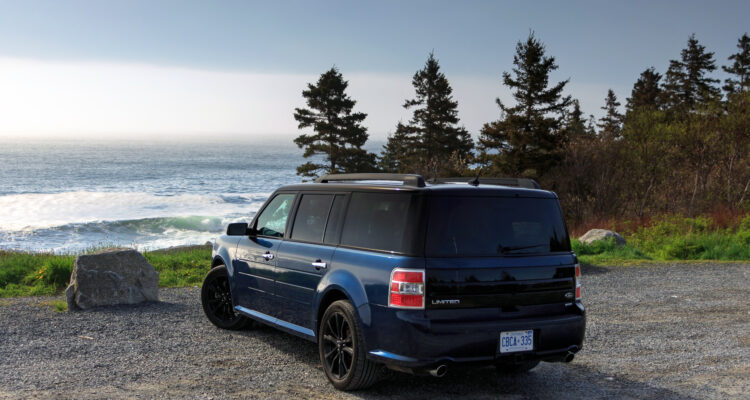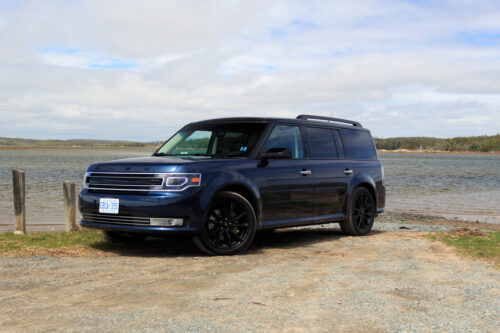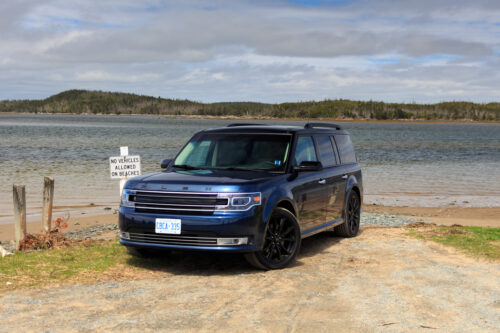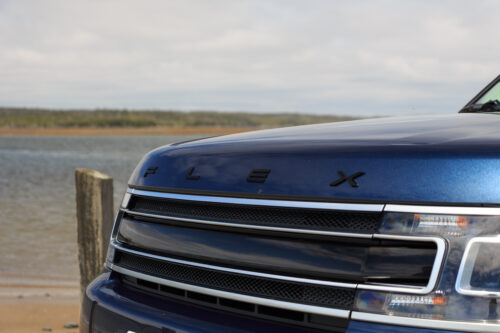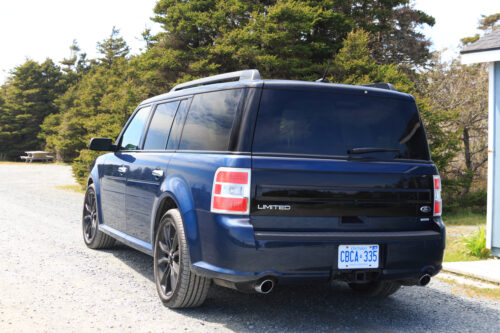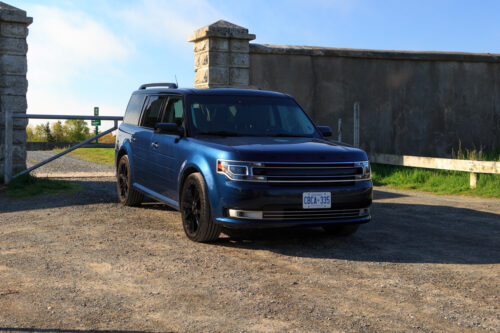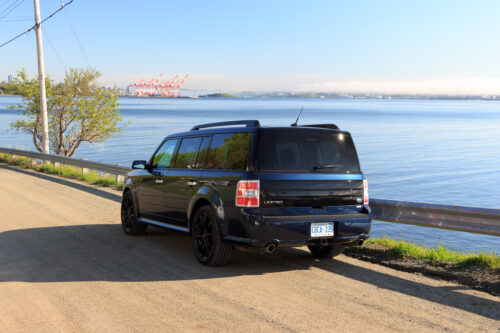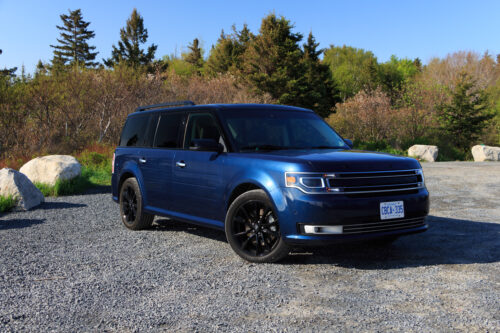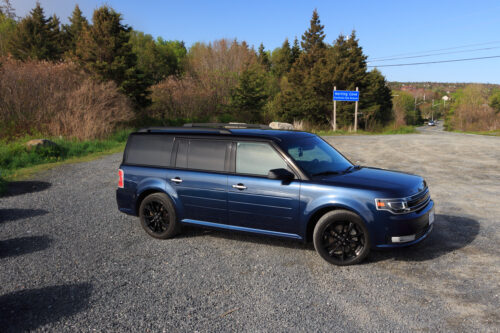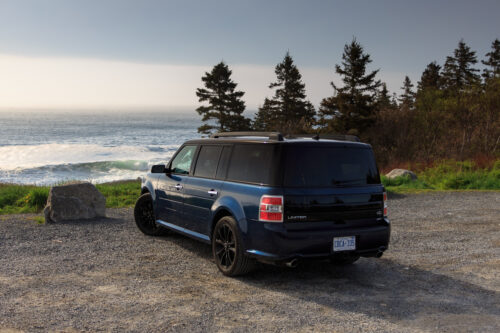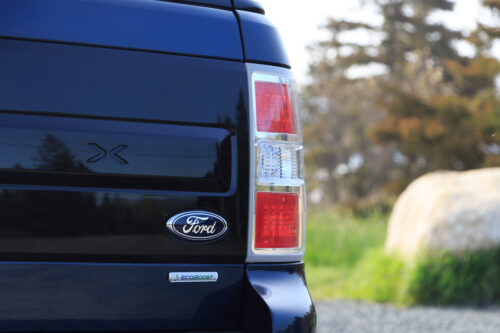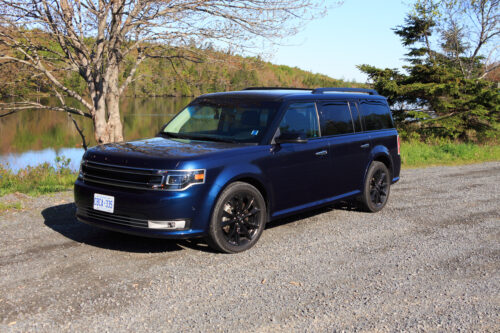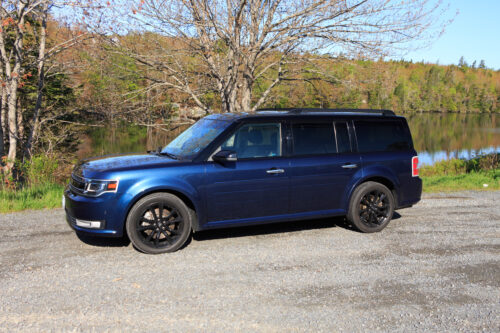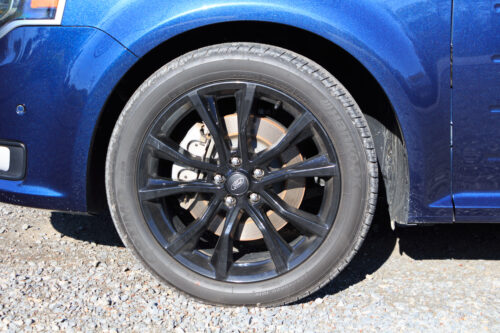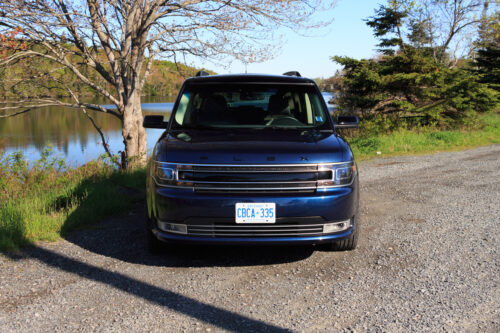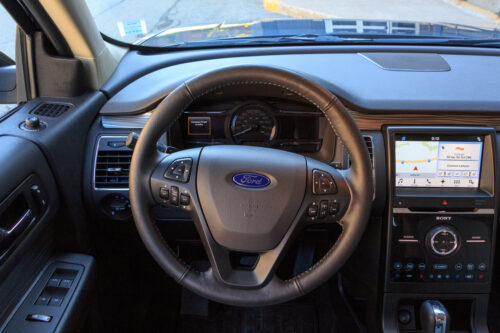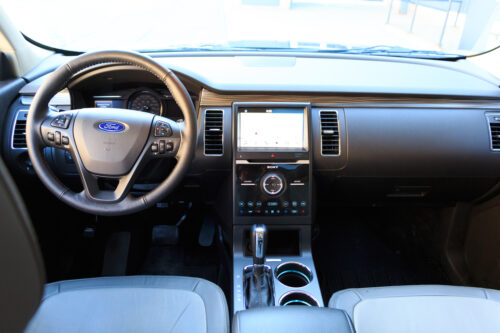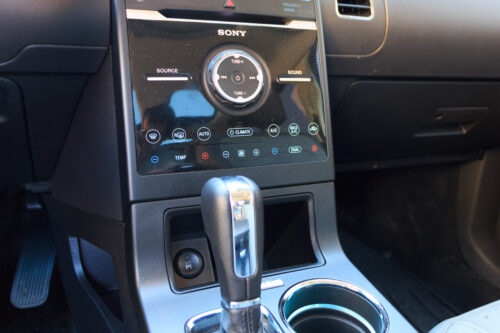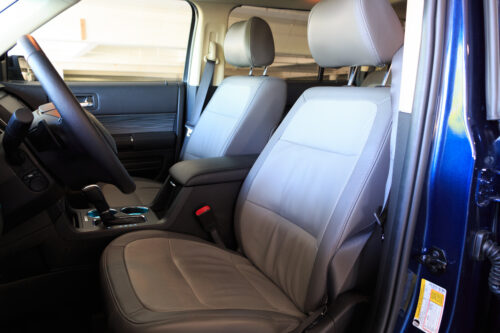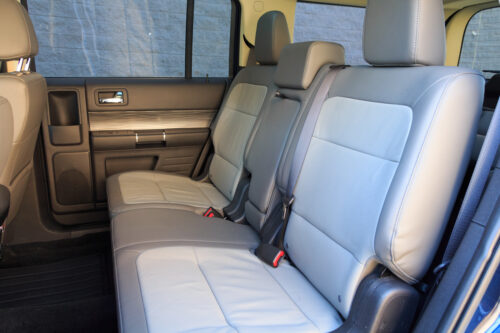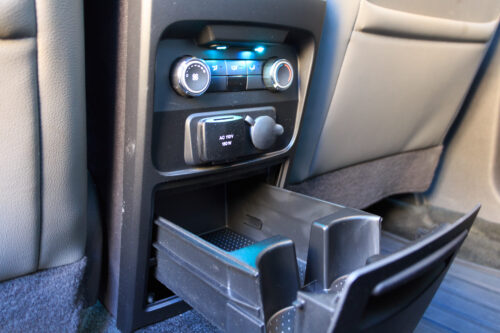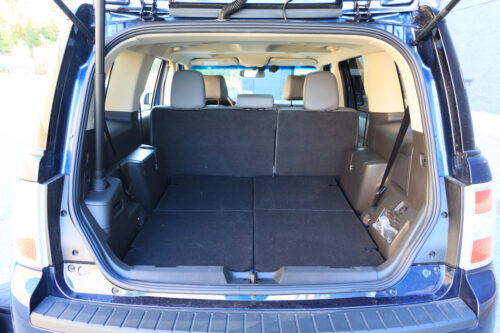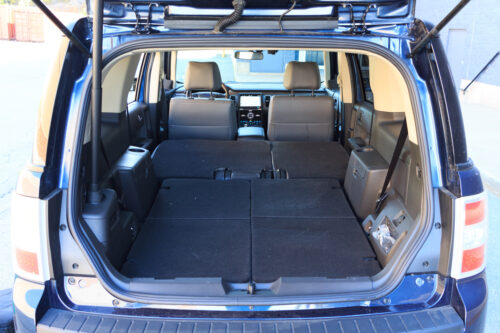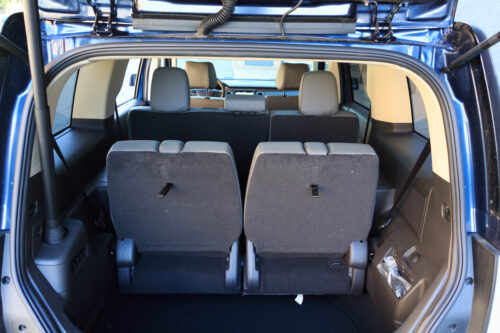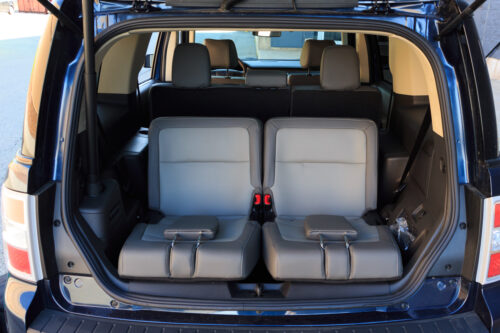Full disclosure: I’ve always been a big fan of Ford’s Flex. Since the reveal of the unabashedly square SUV in 2007, I’ve loved the toaster on wheels styling, the massive side glass, and even the ribs running the length of the sides. But in the years since, I’ve never gotten to spend any time behind the wheel. I’ve finally gotten to change that.
When it was new, the big, boxy styling set it apart from just about everything else. So Ford gave it an ad campaign that was different. Really different. Maybe you remember the skits that aired on the Late Late Show, with Craig Ferguson? To help sell the Flex, Craig created a fake Scottish Hip-Hop group called the Highlanderz. They rapped about being Scottish, and they rapped about the Flex. I’m not sure how lines from the songs like “we’re packing so much heat that our kilts are extra long” was supposed to sell three-row crossovers, but were they ever hilarious to watch. Those ads weren’t the only attempt: Ford even built a handful of Funkmaster Flex, mildly customized by its namesake musician, but good luck finding one.
So it’s got cool styling, and tried to have cool ads, but what’s the Flex really like? Well, for a start, it’s huge. It’s pretty big, at least. The Flex is 5,126mm long. That’s only 56mm shorter than a Chevy Tahoe, and a full 277 mm longer than a Toyota Highlander. That means that there is a ton of space inside. With all the seats up, there is 566 L of cargo space in the back, 175L more than in the Highlander. The middle row offers 1,125 mm of leg room. That’s more than many SUVs give the driver and front passenger. Even the third row, best accessed using the power-fold middle-row seat on the passenger side, has enough legroom and headroom for me to fit comfortably.
On the road, though, the Flex doesn’t feel that big. The upright styling and lack of curves mean that there isn’t much bodywork hiding where you can’t see it. The tall roofline and a surprisingly low beltline give the Flex an absolutely massive greenhouse. All of that glass, and some very thin pillars means that it’s easy to see out of.
Most SUVs I test, and many sedans, have horrible visibility. Enough that I have to back into my driveway because I can’t see out of them well enough to back out of the driveway comfortably. It’s due to a largely ignored stop sign and a poorly placed utility pole, but it’s still a problem I need to deal with. The Flex had such good visibility that I had no problems backing out of the drive. There is a backup camera, but you probably won’t need it. Unless you’re making sure that the rear bumper is actually in the parking space you want, not overlapping into the next one. Like I said, this is a big crossover.
Despite the size, it’s not unreasonably heavy. It’s not light either, but for my EcoBoost-powered, all-wheel drive test vehicle, 2,198 kg doesn’t seem overly heavy. And that 3.5L EcoBoost V6 does a great job of moving those kilos. 355 hp and 350 lb-ft is a pretty big number for a family hauler, and this one hauls. The V6 responds quickly, never feeling like you’re waiting for boost to build. It doesn’t make any turbo-whooshy noises either, which is disappointing. It feels like a good old-fashioned American V8. Low-stress, loads of torque from practically idle. It doesn’t feel like anything is happening, but suddenly you’re moving a lot faster than you thought you were.
The six-speed automatic helps out here as well. In a world of nine and ten-speed automatics that spend days trying to decide which gear they’d like to pick, Ford’s six-speed is a treat. The shifts are fast, decisive, and right. And if you don’t like what the computer wants, there are paddle shifters behind the steering wheel. Which seems absolutely absurd on a three-row SUV, no matter how much power it’s making.
So it’s got a lot of power, but how does it drive? Better than you’d expect. Seriously. This is a big SUV, but it can hustle through corners. The suspension is stiffer than you’d expect, but it’s never harsh. Throw it into a hard corner and let the torque pull it out the other end. The Flex is easy to drive fast. Probably faster than anybody in the back will want you to. On the highway, it tracks true and straight. Despite the flat, tall sides, it’s not thrown around by wind gusts. The steering lacks feel, but that’s no surprise. The ratio is quick though, and the sharp turn-in is a surprise.
Where the Flex starts to feel it’s age is in the interior. It was updated a few years back, but it still shows some age. Take a look at the trim, as well as some of the fit and finish, and it’s easy to see how much the rest of the market has moved on in nearly 10 years. The plastics feel rough, and the headliner pokes out at the edges in a few places. My test car was nearly $60,000, and at that price, the interior needs to be better. Especially against other three-row SUVs like the exquisite interior of the Mazda CX-9.
The infotainment system is Ford’s Sync3 system. It’s quick and responsive, although it’s not always intuitive. Sync handles the climate control as well as the stereo, but most climate functions can be controlled through real buttons. The heated seats and steering wheel are Sync-control only, which is frustrating.
At the pumps, the all-wheel drive and EcoBoost equipped Flex is rated for 15.7 city, 11.2 L/100 km highway. With a good mix of driving, I ended up at 11.4 during my week. That’s an impressive number for something with this much power, room and space. The problem is that the Flex has a short range. Or at least the computer tells you it does. When I filled up after around 450 km, the computer told me I was under 50 km of range. But I only put around 50L into what should be a 70L tank.Turn the car back on and the range shows as a bit over 500km. That’s an extremely pessimistic fuel warning. 500km might be longer than a kid’s bladder lasts on a road trip, but it’s a few hundred km short of what I’d expect, and if you’re willing to push that low fuel light to the max you should probably be able to eek out a much more acceptable 700 km range.
So I went into this loving the Flex. How did I feel about it after driving it? The styling is still my favourite of any big SUV, especially with the single bar grille and prominent FLEX badging on the hood. The EcoBoost engine delivers on the power promises, and this is a genuinely enjoyable SUV to drive. But at this price range, an ageing interior lets it down.
My Flex Limited with the EcoBoost and panoramic roof stickers for $56,649. At that price, there are more luxurious and modern competitors available. But drop the EcoBoost and you save $6,800. Adding back some of the EcoBoost packages active safety features will bump the price back up a bit, but I’ve never been a huge fan of those. An SEL trim with all-wheel drive is $40,899, and that model seems like a bargain.
The Flex has never been a big seller for Ford, and that’s always been a surprise to me. After driving it, I’m still surprised. The Flex is a great way to haul around seven people and a decent amount of stuff. And it looks good doing it, which might be the most important part.
2017 Ford Flex Limited EcoBoost
Price (before taxes): $56,649.00
Freight: $1,690.00
Configuration: front engine / all-wheel drive
Engine/Transmission: 3.5L, twin-turbo 6-cylinder /6-speed automatic
Power/Torque: 365 hp / 350 lb-ft
Fuel (Capacity): Regular (70 L)
Combined fuel economy: 13.7 L / 100 km
Competitors: Honda Pilot, Mazda CX-9, Toyota Highlander
Related links:
Ford Canada



